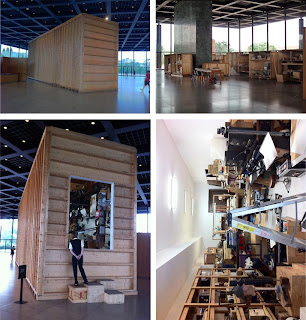Tuesday, July 31, 2012
The artifact previously known as prints
Posted by
jim and Mary
at
7:00 AM
![]()
![]()
Labels: apple, len lye, reconstruction
Monday, July 30, 2012
The rumour mill
Posted by
jim and Mary
at
7:00 AM
![]()
![]()
Labels: auckland art gallery, booster, PR, rumours, Te papa, Walters Prize
Saturday, July 28, 2012
Bus boy
Posted by
jim and Mary
at
7:00 AM
![]()
![]()
Labels: animated public transport
Friday, July 27, 2012
Sometimes...
Head job
Posted by
jim and Mary
at
6:40 AM
![]()
![]()
Labels: art in the movies, fabrication
Thursday, July 26, 2012
Go for gold
Property developer James Young on the statue of Keith Holyoake his company inherited with the States Services Commission building in the DomPost
Posted by
jim and Mary
at
12:00 PM
![]()
![]()
Labels: public sculpture, quote
When art goes to the movies: Edward Hopper
Posted by
jim and Mary
at
7:00 AM
![]()
![]()
Labels: art in the movies
Wednesday, July 25, 2012
Show them the door
Posted by
jim and Mary
at
6:45 AM
![]()
![]()
Labels: audience, city gallery, funding
Tuesday, July 24, 2012
Fair appraisal
Posted by
jim and Mary
at
12:00 PM
![]()
![]()
Labels: art fair, melbourne art fair
Card sharps
Monday, July 23, 2012
Best bets
Posted by
jim and Mary
at
7:00 AM
![]()
![]()
Labels: Walters Prize
Saturday, July 21, 2012
Arms wide open
Posted by
jim and Mary
at
7:00 AM
![]()
![]()
Labels: artists pose
Friday, July 20, 2012
Look, up there in the sky. It’s a bird. It’s a plane. It’s a public sculpture
Posted by
jim and Mary
at
12:00 PM
![]()
![]()
Labels: lookalike, public sculpture
Pic one
Posted by
jim and Mary
at
6:52 AM
![]()
![]()
Labels: exhibitions, lookalike
Thursday, July 19, 2012
Yoink
Posted by
jim and Mary
at
7:00 AM
![]()
![]()
Labels: art in the movies
Wednesday, July 18, 2012
By the numbers
3 the number in millions of dollars that the Government gives Te Papa each year to purchase work for its collections
3.03 the number of minutes it takes to demolish the apartment block next to the Christchurch Art Gallery in stop-motion
13 the number of commissioned works in the Auckland Art Gallery’s Pacific Island exhibition Home AKL
16 the number of people who applied to be director of the Dunedin Public Art Gallery
32.4 the percentage of Te papa staff who are unionised
49,636 number of air-kilometres flown by Walters Prize artists getting to Auckland to set up the exhibition
Posted by
jim and Mary
at
7:00 AM
![]()
![]()
Labels: by the numbers
Tuesday, July 17, 2012
Man in a box
Monday, July 16, 2012
Magolles gets an airing
Posted by
jim and Mary
at
12:00 PM
![]()
![]()
Labels: controversy, installation
The even more anxious object
Saturday, July 14, 2012
Friday, July 13, 2012
Ceci n'est pas une demi-pipe
Posted by
jim and Mary
at
7:00 AM
![]()
![]()
Labels: public sculpture, serra
Thursday, July 12, 2012
Future shock
Posted by
jim and Mary
at
7:00 AM
![]()
![]()
Wednesday, July 11, 2012
Spitting image
Posted by
jim and Mary
at
7:00 AM
![]()
![]()
Labels: architecture, exhibitions, history
Tuesday, July 10, 2012
It’s only words
Posted by
jim and Mary
at
7:00 AM
![]()
![]()
Labels: admin, auckland art gallery, curators
Monday, July 09, 2012
In Berlin
Posted by
jim and Mary
at
11:00 AM
![]()
![]()
Labels: thinking about
Fur real
Fact is The Barefoot Potter Boys Brigade by Michael Parekowhai has spent a good deal of its time in traveling exhibitions and over the years the lighting has faded the fugitive blue of the felt on one jacket (the brown jacket on the other rabbit still looks like new). Mark Amery suggested when reviewing the Dowse Art Museum's show Critical mass a few months ago that “without the attentions of public conservators how many of these works would have survived?”
He went on to say, “Left to private collection could we quickly bring together celebrations of the work of the recently deceased?” Well, yes of course you could. And in the case of loans the private collectors we have met are a good deal (and we mean a good deal) more obliging and fast to respond than the average art museum.
When it comes to a work's survival getting a new jacket made is part of the price of owning an artwork that wears one. After all, the boys need to look good when they’re out there on loan to public institutions.
Images: Top left, the workshop where the coat was made. Bottom left the new pattern, middle the new and old coats and right Michael Parekowhai’s Barefoot Potter Boys in their original regalia.
Posted by
jim and Mary
at
7:00 AM
![]()
![]()
Labels: conservation, media, private collector
Saturday, July 07, 2012
Can we just see a little more of the zebra?
Posted by
jim and Mary
at
7:00 AM
![]()
![]()
Labels: artists pose, zebra
Friday, July 06, 2012
This image wants to be your friend
Posted by
jim and Mary
at
7:00 AM
![]()
![]()
Labels: photography
Thursday, July 05, 2012
One day at the Japanese sex toy manufacturers
Posted by
jim and Mary
at
6:10 AM
![]()
![]()
Labels: one day in, sex toys
Wednesday, July 04, 2012
Boxed in
Posted by
jim and Mary
at
12:00 PM
![]()
![]()
Labels: lookalike (not)
Jeff in Frankfurt
Tuesday, July 03, 2012
What’s in that crate?
Posted by
jim and Mary
at
6:29 AM
![]()
![]()
Labels: crate, exhibitions, exporting





























































